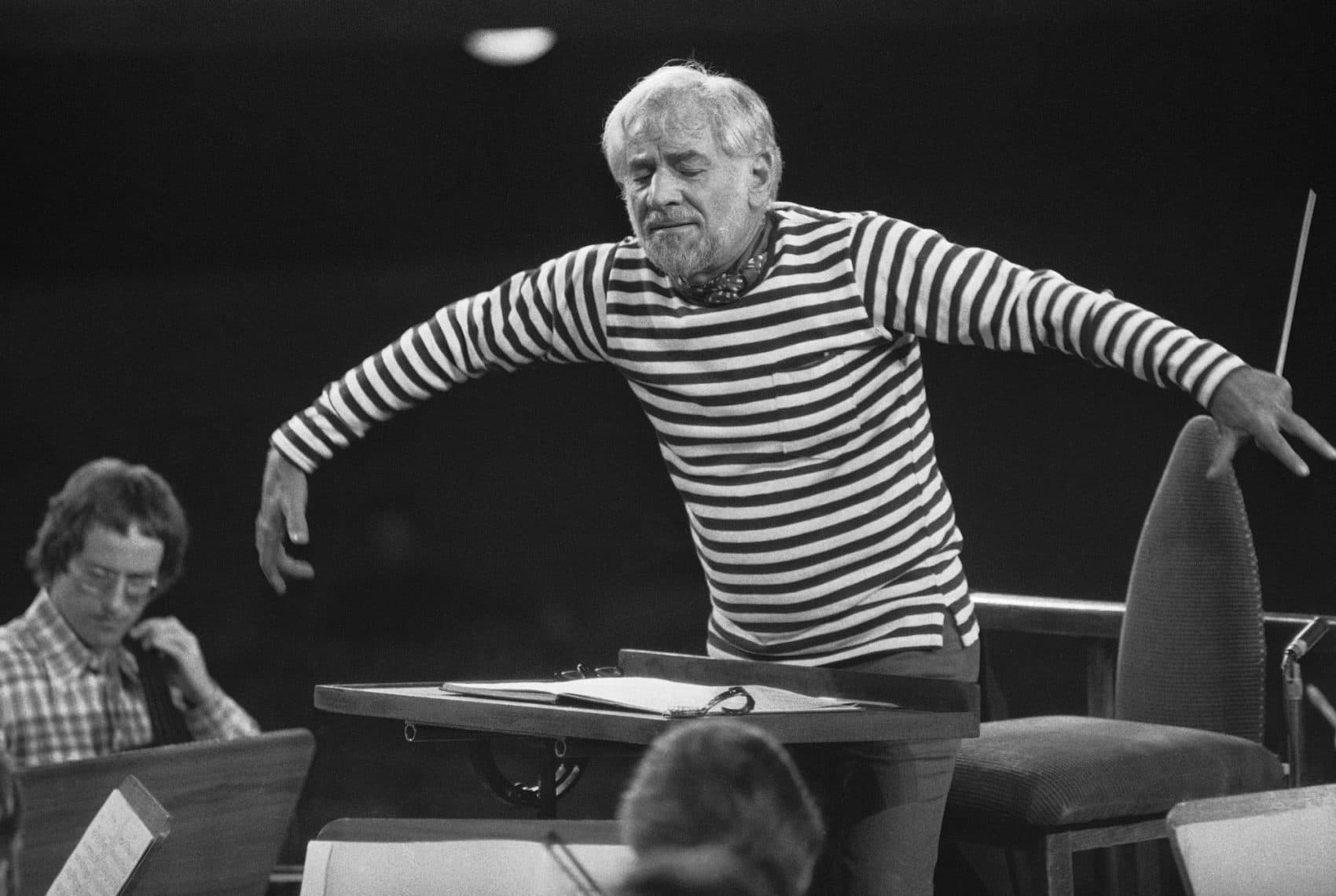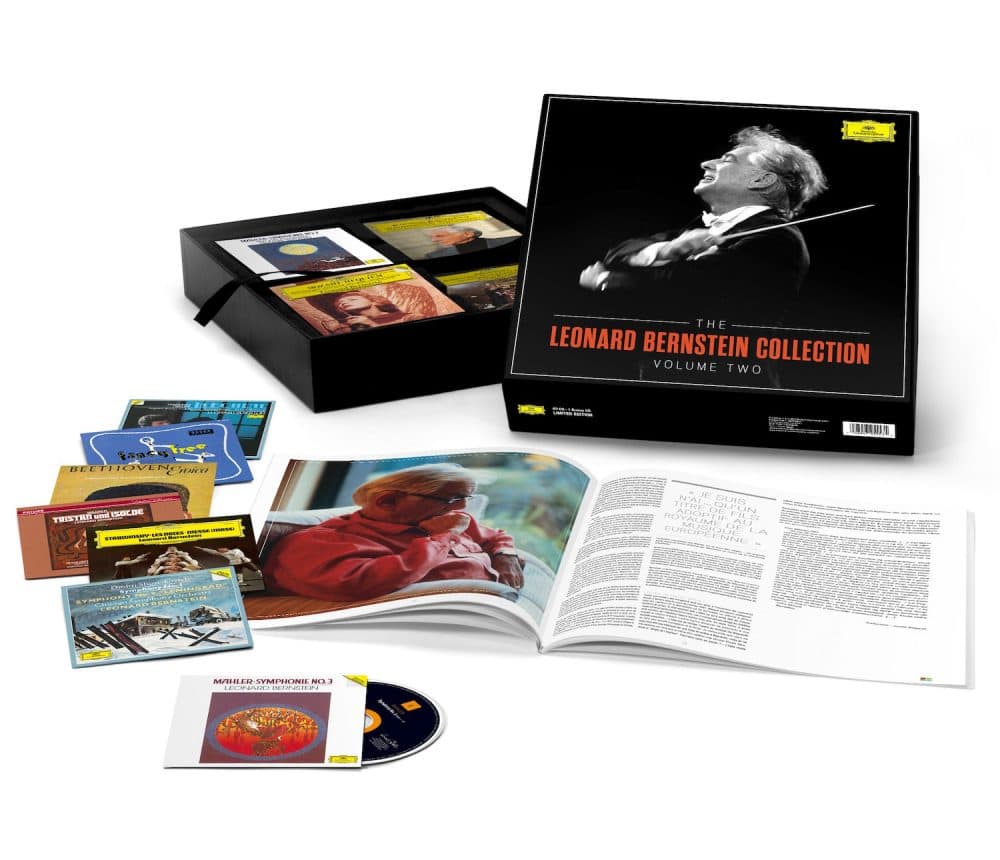Advertisement
The All-Embracing Legacy Of Leonard Bernstein: The DG Years

One of the great summer highlights for me from 1984 to 1990 was the ride west to Tanglewood to hear Leonard Bernstein conduct the Boston Symphony Orchestra. It seemed in those years that the musicians would lean forward a little more and come up with music that would make the Berkshire hills even more Edenic.
These were amazing performances, noteworthy in part for how Bernstein had slowed the tempos for much of the music, but also for their sense of architecture. It’s as if he and the BSO — and the audiences — were luxuriating in every note.
Unfortunately for the BSO, Bernstein would then go off and conduct the same material with the New York Philharmonic and the Vienna Philharmonic for Deutsche Grammophon. Still, as the Berkshires beckon sans Bernstein, the thrill of those performances come roaring back with Volume Two (Mahler to Wagner) of “The Leonard Bernstein Collection” on DG. (The two go for about $150 each.)
This volume — mostly from the 1980s and ‘90s — is a treasure trove of mostly romantic repertoire. If the first volume began with the bang of the Three B’s (Beethoven, Brahms and – wait for it – Bernstein) here we have the Three M’s – Mahler, Mendelssohn and Mozart. Bernstein’s legacy with Mahler is well-documented. There’s much to love about his first two Mahler cycles (the first for Columbia, the second for video), but these ‘80s recordings with New York, Vienna and Amsterdam are the most elegiac of the three, and are the most pristinely recorded. Part of him must have known that these would be his final meetings with Mahler and he wanted to make the most of his time with him. (There’s much to admire in all three cycles, though if I had to pick one it would be the mid-career video set.)
But his recordings of the late Mozart symphonies with the Vienna Philharmonic are notable for a more sprightly touch. If he’s discussing the great issues of the 19th and 20th Centuries with Mahler, he’s having a burger and a beer with Mozart while discussing his similarities to Beethoven. As for the third M, Claudio Abbado and Christoph von Dohnanyi were Mendelssohn specialists, but Bernstein’s recordings of the “Hebrides” overture and the last three symphonies with the Israel Philharmonic are particular favorites. Bernstein’s next round of performances with the New Yorkers would have been Mendy’s “Elijah” oratorio and these lush recordings make you lust for what might have been if he hadn’t passed away in 1990.
Then there are the six S’s – Schubert, Schumann, Shostakovich, Sibelius, Richard Strauss and Stravinsky. The New York Philharmonic recordings on Columbia/Sony are generally more exciting – notably “The Rite of Spring” — but Bernstein is more self-assured later in life. He knows what he wants to say and exactly what he wants from the orchestras. And the sound is light years better than on the earlier Columbia recordings.
Advertisement

By the luck of the alphabet, the M-Z volume is primarily concerned with Bernstein the conductor and pianist performing the late-romantic repertoire, but it also goes back to his early years as a composer and teacher, the latter with his delightful 1953 Decca music-appreciation analyses of Beethoven, Dvorak, Brahms, Schumann and Tchaikovsky. The box ends with Bernstein’s early recordings of selections from “Fancy Free” (with Billie Holiday) and “On the Town” (with Mary Martin). There's also a significant stretch into the 20th Century with Sibelius, Shostakovich and Stravinsky.
But going back to Tanglewood, Bernstein conducted the last three Tchaikovsky symphonies late in life and each seemed to be an occasion — actually all his appearances with the BSO were occasions. His Mahlerian, intensely dramatic Tchaikovsky Sixth was paired with Midori’s memorable performance of Bernstein’s “Serenade”; he performed the Fifth at his 70th birthday gala; and the Fourth with the Tanglewood Music Center Orchestra students, who always played their hearts out for him.
As you can hear on these recordings with the New York Philharmonic, the tempos were quite a bit slower in the ‘80s and not to everyone’s taste. John Rockwell, the Times critic, put it best when he reviewed the Tanglewood gala:
Some might hear Mr. Bernstein's Tchaikovsky as self-indulgent, but to this taste the indulging was for Tchaikovsky. In other words, the very point of this music is that it is breast-beating Romanticism, and nobody beats breasts better than Mr. Bernstein. The music sounded soulful, weepy and impassioned by turns, and the ovation at the end was more than justified, just for this performance alone.
But, of course, the cheering was also for Mr. Bernstein, who despite all of his emotional extremes (or perhaps because of them) has awakened a loving responsiveness in the American public for more than 40 years. When he finally spoke, hoarsely and without amplification, he offered ''450,000 thanks'' to all the instrumentalists, singers, technicians and others who had made his birthday bash such a success. His remarks were dignified and gracious, and they brought what had been a really winning celebration to a happy close.
The two volumes of the Bernstein Collection recall a different time in the classical-music world. These recordings were originally released three or four at a time when there was still an enormous appetite for LPs and then CDs. Now it’s a big deal if an orchestra or conductor records three or four times in a year. He had re-signed with DG before his death and would have been able to conduct anything he wanted.
But give DG credit. These two LP-sized boxes make that history come alive with the handsome original-jacket artwork, most containing that iconic yellow banner. For Bernstein, the DG contract symbolized that he was considered one of the world’s great maestros, which wasn’t a given in his New York/Columbia years.
All that’s missing from the DG boxes is the moving “Music for Life” concert from 1987, in which Bernstein, James Levine, Yo-Yo Ma, Luciano Pavarotti and others came together for a great night of music-making to benefit those suffering with AIDS, a far more lethal disease back then, of course. It ends with Marilyn Horne's unbeatable three "Old American Songs" of Copland and Bernstein and Mozart playing the andante from Mozart's "Sonata for Two Pianos in D."
Through it all, music was never just notes for Bernstein. It was a way of speaking truth to power, of dealing with all the scourges of the 20th Century, to make the souls of all who listened come fully alive. Blessings on DG for capturing that record so brilliantly.


